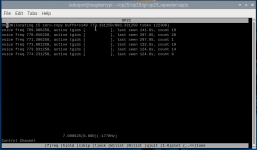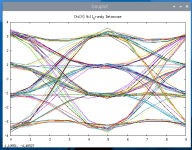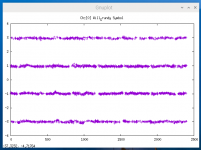OP25 is very configurable and I think that for me this is adding some confusion. I am attempting to configure a P25 simulcast system which includes some TMDA talk groups. The site I am trying to configure has 12 frequencies with 3 of them configured as control channels. The split for the frequencies is 5.75, so I have 3 SDR's plugged in.
I am trying to create the config.json file and have learned a lot, but am still missing a few things. I am hoping one of you will help me grasp the configuration of OP25 so I can finish getting it configured. My thought is to start with local audio coming out of the raspberry pi speaker jack. Once I figure that out I would like to try to stream different streams from the same system. Below is my config.json. Please let me know where I am making mistakes. I calculated the frequencies for the SDR based on a 2MHZ from top and bottom and the difference in the middle. If there is a better way to do this let me know.
{
"channels": [
{
"name": "Will_Grundy",
"device": "SDR0",
"trunking_sysname": "Starcom_WillGrundy_Site",
"demod_type": "cqpsk",
"cqpsk_tracking": true,
"tracking_threshold": 120,
"tracking_limit": 2400,
"tracking_feedback": 0.75,
"destination": "udp://127.0.0.1:56120",
"excess_bw": 0.2,
"filter_type": "rc",
"frequency": 773331250,
"if_rate": 24000,
"plot": "symbol",
"symbol_rate": 4800,
"blacklist": "",
"whitelist": ""
}
],
"devices": [
{
"args": "rtl=0",
"frequency": 772.831300,
"gains": "lna:39",
"gain_mode": false,
"name": "SDR0",
"offset": 0,
"ppm": 0.0,
"rate": 1000000,
"usable_bw_pct": 0.85,
"tunable": true
},
{
"args": "rtl=1",
"frequency": 772.45630,
"gains": "lna:39",
"name": "SDR1",
"offset": 0,
"ppm": 0.0,
"rate": 1000000,
"usable_bw_pct": 0.85,
"tunable": true
},
{
"args": "rtl=2",
"frequency": 770.081300,
"gains": "lna:39",
"name": "SDR2",
"offset": 0,
"ppm": 0.0,
"rate": 1000000,
"usable_bw_pct": 0.85,
"tunable": true
}
],
"trunking": {
"module": "tk_p25.py",
"chans": [
{
"nac": "0x14d",
"sysname": "Starcom_WillGrundy_Site",
"control_channel_list": "773.33125,77483125,77090625",
"whitelist": "",
"tgid_tags_file": "Grundy.tsv",
"crypt_behavior": 2
}
]
},
"audio": {
"module": "sockaudio.py",
"instances": [
{
"instance_name": "audio0",
"device_name": "default",
"udp_port": 23456,
"audio_gain": 1.0,
"number_channels": 1
}
]
},
"terminal": {
"module": "terminal.py",
"terminal_type": "curses",
"#terminal_type": "http:127.0.0.1:8081",
"terminal_timeout": 5.0,
"default_channel": "Will_Grundy",
"curses_plot_interval": 0.2,
"http_plot_interval": 1.0,
"http_plot_directory": "../www/images",
"tuning_step_large": 1200,
"tuning_step_small": 100
}
}

Why does the top line have 773.331250/803.33125? I did not enter the 800 frequency. Is this something it is reading from the control channel data stream?


I am trying to create the config.json file and have learned a lot, but am still missing a few things. I am hoping one of you will help me grasp the configuration of OP25 so I can finish getting it configured. My thought is to start with local audio coming out of the raspberry pi speaker jack. Once I figure that out I would like to try to stream different streams from the same system. Below is my config.json. Please let me know where I am making mistakes. I calculated the frequencies for the SDR based on a 2MHZ from top and bottom and the difference in the middle. If there is a better way to do this let me know.
{
"channels": [
{
"name": "Will_Grundy",
"device": "SDR0",
"trunking_sysname": "Starcom_WillGrundy_Site",
"demod_type": "cqpsk",
"cqpsk_tracking": true,
"tracking_threshold": 120,
"tracking_limit": 2400,
"tracking_feedback": 0.75,
"destination": "udp://127.0.0.1:56120",
"excess_bw": 0.2,
"filter_type": "rc",
"frequency": 773331250,
"if_rate": 24000,
"plot": "symbol",
"symbol_rate": 4800,
"blacklist": "",
"whitelist": ""
}
],
"devices": [
{
"args": "rtl=0",
"frequency": 772.831300,
"gains": "lna:39",
"gain_mode": false,
"name": "SDR0",
"offset": 0,
"ppm": 0.0,
"rate": 1000000,
"usable_bw_pct": 0.85,
"tunable": true
},
{
"args": "rtl=1",
"frequency": 772.45630,
"gains": "lna:39",
"name": "SDR1",
"offset": 0,
"ppm": 0.0,
"rate": 1000000,
"usable_bw_pct": 0.85,
"tunable": true
},
{
"args": "rtl=2",
"frequency": 770.081300,
"gains": "lna:39",
"name": "SDR2",
"offset": 0,
"ppm": 0.0,
"rate": 1000000,
"usable_bw_pct": 0.85,
"tunable": true
}
],
"trunking": {
"module": "tk_p25.py",
"chans": [
{
"nac": "0x14d",
"sysname": "Starcom_WillGrundy_Site",
"control_channel_list": "773.33125,77483125,77090625",
"whitelist": "",
"tgid_tags_file": "Grundy.tsv",
"crypt_behavior": 2
}
]
},
"audio": {
"module": "sockaudio.py",
"instances": [
{
"instance_name": "audio0",
"device_name": "default",
"udp_port": 23456,
"audio_gain": 1.0,
"number_channels": 1
}
]
},
"terminal": {
"module": "terminal.py",
"terminal_type": "curses",
"#terminal_type": "http:127.0.0.1:8081",
"terminal_timeout": 5.0,
"default_channel": "Will_Grundy",
"curses_plot_interval": 0.2,
"http_plot_interval": 1.0,
"http_plot_directory": "../www/images",
"tuning_step_large": 1200,
"tuning_step_small": 100
}
}

Why does the top line have 773.331250/803.33125? I did not enter the 800 frequency. Is this something it is reading from the control channel data stream?



